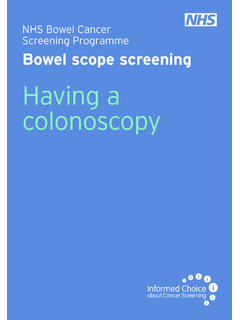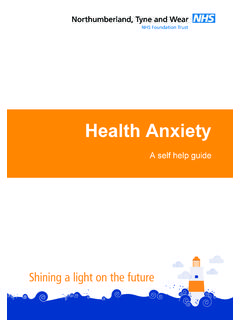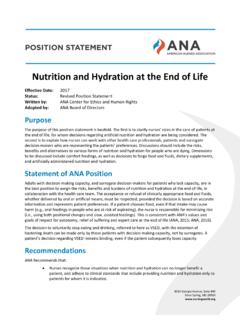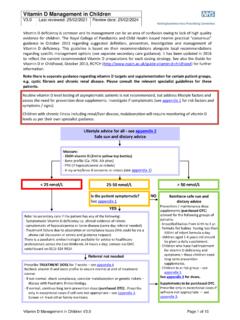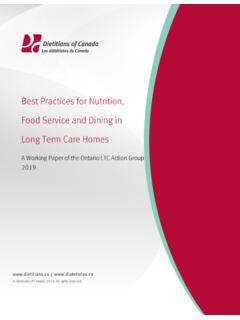Transcription of Vitamin D position statement - NHS
1 09/12/10 Consensus Vitamin D position statement Summary Everyone needs Vitamin D, which is essential for good bone health. Low levels are linked to bone conditions such as rickets in children, and osteomalacia and osteoporosis in adults. There is currently no standard definition of an optimal level of Vitamin D. The consensus is that levels of 25(OH)D below 25nmol/L indicate deficiency . Some have argued that this level is conservative. Raising the definition of deficiency or sufficiency to higher levels is inappropriate until results from randomised trials can show that maintaining such levels has clear health benefits and no health risks.
2 The evidence suggesting that Vitamin D might protect against cancer, heart disease, diabetes, multiple sclerosis and other chronic diseases is still inconclusive. Some studies have suggested that high levels of Vitamin D are associated with a reduced risk of bowel cancer although the mechanism has yet to be elucidated. For other cancers, the evidence is inconsistent or limited. Even for bowel cancer, it is too early to say if Vitamin D directly protects against this cancer or if it reflects another aspect of our health. Sun exposure is the main source of Vitamin D, but excessive sun exposure is the main cause of skin cancer, including melanoma, the fastest rising type of cancer in the UK.
3 Enjoying the sun safely, while taking care not to burn, can help to provide the benefits of Vitamin D without unduly raising the risk of skin cancer. It is impractical to offer a one-size-fits-all recommendation for the amount of sun exposure that people need to make sufficient Vitamin D, because this varies according to a number of environmental, physical and personal factors. The time required to make sufficient Vitamin D is typically short and less than the amount of time needed for skin to redden and burn. Regularly going outside for a matter of minutes around the middle of the day without sunscreen should be enough.
4 When it comes to sun exposure, little and often is best, and the more skin that is exposed, the greater the chance of making sufficient Vitamin D before burning. However, people should get to know their own skin to understand how long they can spend outside before risking sunburn under different conditions. Vitamin D supplements, fortified fat spreads and dietary sources such as oily fish (including salmon, trout and sardines) can be useful for helping to maintain sufficient levels of Vitamin D. These sources are particularly important during the winter and among people at higher risk of Vitamin D deficiency, including pregnant and breastfeeding women, young children, older people, darker-skinned people, those who wear whole-body coverings, those liv ing in institutions, skin cancer patients and those who avoid the sun.
5 People at risk of low sun exposure should take a 10 microgram supplement of Vitamin D a day (7 micrograms a day for children aged 6 months to 5 years), which is the Government-recommended dose. There is not enough evidence to support a recommendation for food fortification or widespread Vitamin D supplementation for the general population. Unlike Vitamin D produced in the skin, there is the potential that Vitamin D from supplements and fortificants could build up to toxic levels and there is not enough evidence about the possible risks of raised Vitamin D blood levels in the general population over a long period of time.
6 This consensus statement represents the unified views of the British Association of Dermatologists, Cancer Research UK, Diabetes UK, the Multiple Sclerosis Society, the National Heart Forum, the National Osteoporosis Society and the Primary Care Dermatology Society. Vitamin D is essential for good bone health and for most people sunlight is the most important source of Vitamin D. The time required to make sufficient Vitamin D varies according to a number of environmental, physical and personal factors, but is typically short and less than the amount of time needed for skin to redden and burn. Enjoying the sun safely, while taking care not to burn, can help to provide the benefits of Vitamin D without unduly raising the risk of skin cancer.
7 Vitamin D supplements and specific foods can help to maintain sufficient levels of Vitamin D, particularly in people at risk of deficiency. However, there is still a lot of uncertainty around what levels qualify as optimal or sufficient , how much sunlight different people need to achieve a given level of Vitamin D, whether Vitamin D protects against chronic diseases such as cancer, heart disease and diabetes, and the benefits and risks of widespread supplementation. 09/12/10 Vitamin D requirements The level of 25-hydroxyvitamin D (25(OH)D) in the blood is the best indicator of Vitamin D status. There is consensus that levels below 25nmol/L (10ng/ml) qualify as deficient ,1, 2 but beyond this there is currently no standard definition of optimal 25(OH)D , 4 There is also lack of standardization of methods used to measure 25(OH)D status, with different tests producing very different Some scientists suggest that levels above 50nmol/L (20ng/ml) are sufficient , while 70 80nmol/L (28-32ng/ml) is optimal.
8 1, 6, 7 However, raising the definition of deficiency or sufficiency is currently inappropriate since no results from randomised trials suggest that maintaining such levels of 25(OH)D prevents chronic diseases. It is also unclear whether these levels are practical for all individuals, given that various studies have found that that 25(OH)D levels plateau at around 70-80nmol/L, with wide variation across , 9 For example, a Hawaiian study found that half of healthy, young surfers had levels below 75nmol/L despite extensive unprotected outdoor exposure and tanned The Department of Health currently recommends a daily 10 microgram Vitamin D supplement for those at risk of Vitamin D deficiency, including all pregnant and breastfeeding women, older people and those at risk of inadequate sun exposure (for example those who cover their skin for cultural reasons or those confined indoors).
9 A daily Vitamin D supplement of 7 micrograms is also recommended for all children aged 6 months to 5 years. 2 The National Institute for Health and Clinical Excellence (NICE) also emphasises the importance of maintaining adequate Vitamin D during pregnancy and breastfeeding, and suggests that women may choose to take up to 10 g of Vitamin D a day during these Factors affecting Vitamin D levels and groups at high risk of Vitamin D deficiency The amount of UVB in sunlight changes substantially with season, latitude and time of These factors greatly affect Vitamin D production, which is greatest around two hours either side of solar noon, and during summer months.
10 Physical characteristics can also affect Vitamin D production, with darker skin requiring longer UV exposures to produce the same amount of Vitamin , 13 Older people have a reduced ability to make Vitamin D through their Obese people have lower 25(OH)D levels, which may be due to less sun exposure or greater uptake of Vitamin D in fat tissue, which may be more Certain groups of people have a higher risk of Vitamin D deficiency including those with darker skin,12, 13 those who wear whole-body coverings,16, 17 older people,14 pregnant women,18 infants born to Vitamin D-deficient mothers,19 skin cancer patients, those who are housebound or in institutions, and those who avoid the Some studies have found that sunscreen use reduces Vitamin D However.
